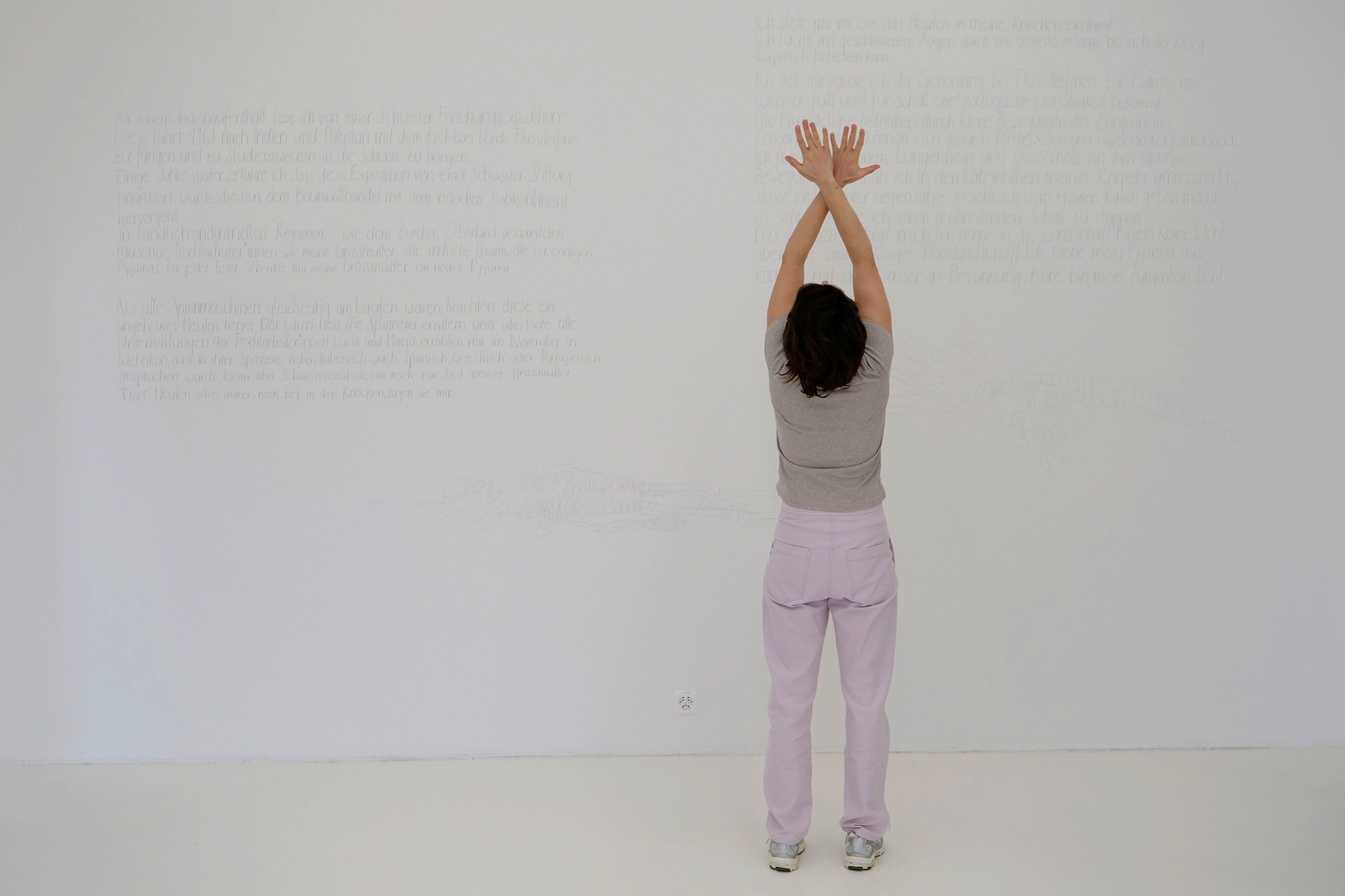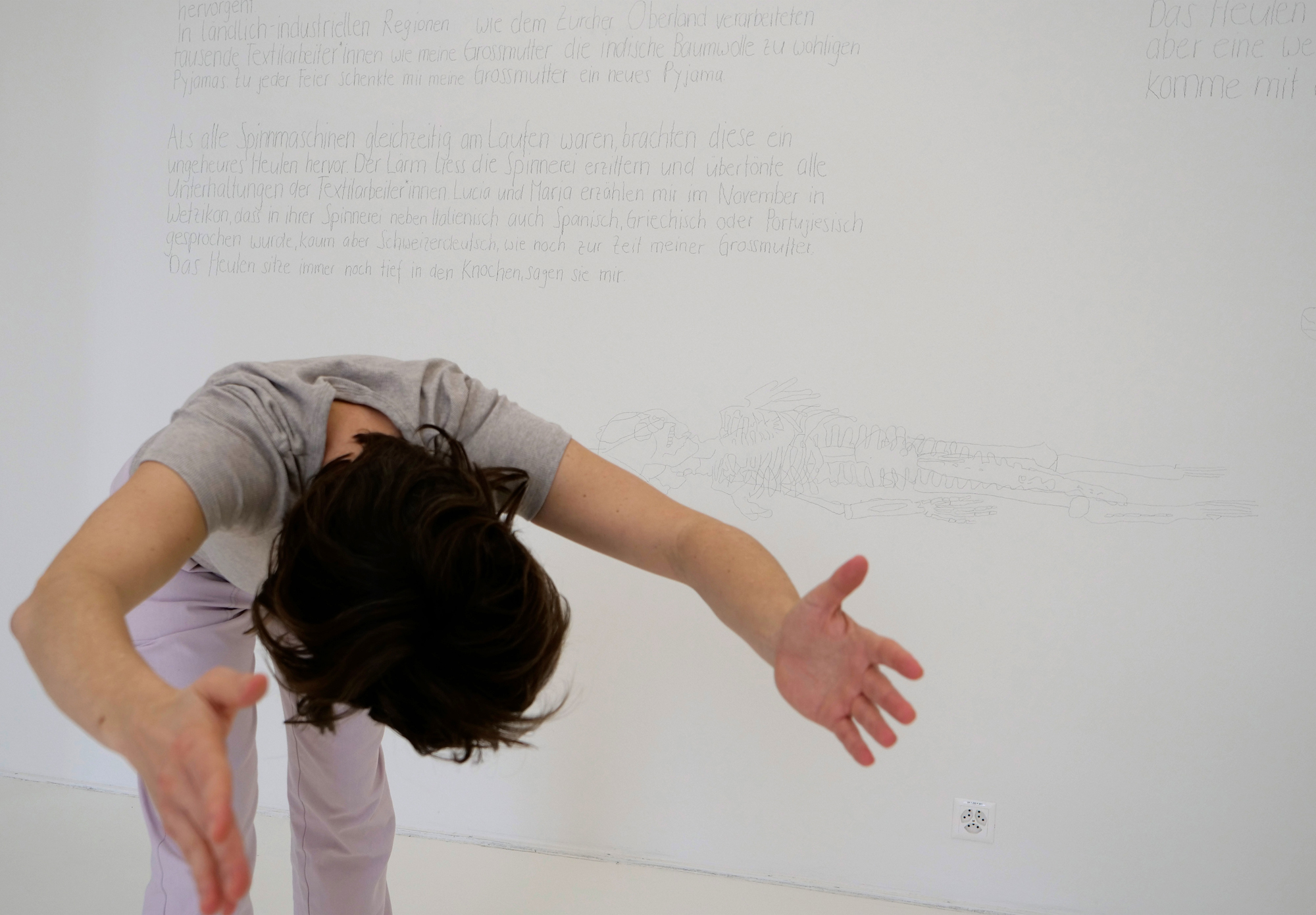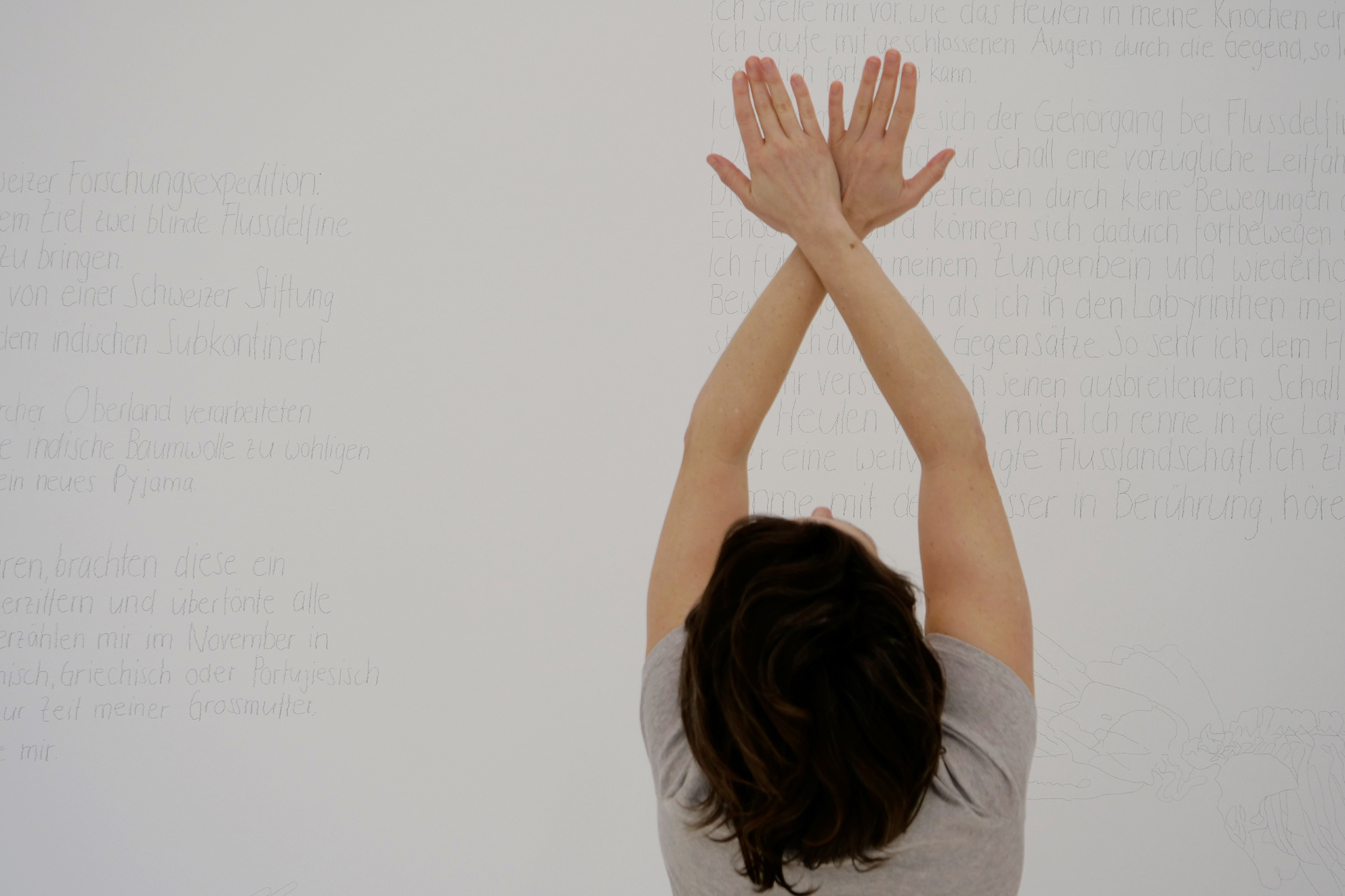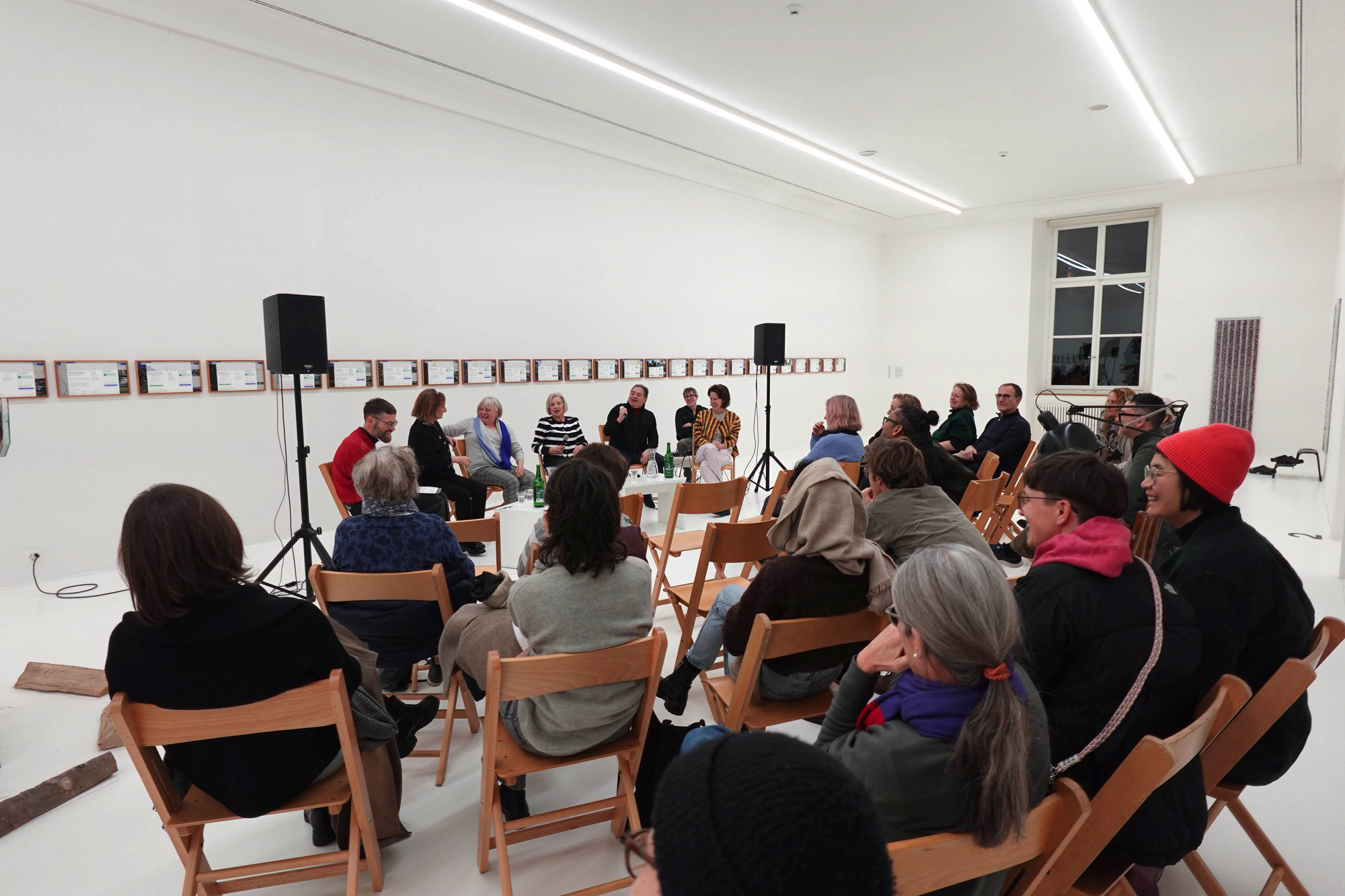Scores for a Ganges River Dolphin and a Textile Worker #2
Installation with live performance accompanied by a conversation with textile workers
The performance project Scores for a Ganges River Dolphin and a Textile Worker was further developed and expanded for the group exhibition Wirtschaft mit Armut. Kunst ist Klasse! (Economy with Poverty. Art is Class!) at the Helmhaus Zurich.
The movement performance on February 7, 2025, at the Helmhaus Zurich took place in front of the handwritten wall text which is part of the work.
Following the performance, there was a discussion with the artist and guests: Maria Gallelli and Lucia Passaseo, former textile workers at the Streiff spinning mill, talked about the work processes involved in operating a spinning machine, which were important for Stefanie Knobel's performance. Anna Häni also reported on the feminist round table GRUPPO DONNE ITALIANE, founded in 1986 with Marianna Bassu in Wetzikon.
Documentation Scores for a Ganges River Dolphin and a Textile Worker, 2025. Camera: Sarai Aron.

Performance view Scores for a Ganges River Dolphin and a Textile Worker #2, February 7, 2025. Photo: Sarai Aron.

Performance view Scores for a Ganges River Dolphin and a Textile Worker #2, February 7, 2025. Photo: Sarai Aron.

Performance view Scores for a Ganges River Dolphin and a Textile Worker #2, February 7, 2025. Photo: Sarai Aron.
The following text is the english translation of the handwritten wall text as part of Scores for a Ganges River Dolphin and a Textile Worker #2:
Before a trip to India, I read about a Swiss research expedition that took place in 1969, traveling to India and Pakistan with the aim of capturing two blind river dolphins and bringing them to Switzerland for study purposes.
A few years later, I learned that this expedition was financed by a Swiss foundation that had its origins in the cotton trade with the Indian subcontinent. In rural-industrial regions such as the Zurich Oberland, thousands of textile workers like my grandmother processed Indian cotton into cozy pajamas. My grandmother gave me a new pair of pajamas for every celebration.
When all the spinning machines were running at the same time, they produced an enormous howling noise. The noise shook the spinning mill and drowned out all the conversations of the textile workers. Lucia and Maria tell me in November in Wetzikon that in their spinning mill, Spanish, Greek, and Portuguese were spoken alongside Italian, but hardly any Swiss German, as was still the case in my grandmother's day. The howling is still deeply ingrained in their bones, they tell me.
I imagine the howling penetrating my bones. I walk around with my eyes closed until the sound can continue physically. I imagine how the ear canal of river dolphins fills completely with water and becomes an excellent conductor of sound. River dolphins use small movements of the hyoid bone to echolocate, enabling them to move around and communicate with each other. I feel my hyoid bone and repeat individual movements on it. But as I wander through the labyrinths of my body, I encounter nothing but contradictions. As much as I want to give the howling space, I try to stop its spreading sound. The howling haunts me. I run into the landscape. Not a desert, but a widely ramified river landscape. I take off my pyjamas, come into contact with the water, listen, my hyoid bone trembles.
A few years later, I learned that this expedition was financed by a Swiss foundation that had its origins in the cotton trade with the Indian subcontinent. In rural-industrial regions such as the Zurich Oberland, thousands of textile workers like my grandmother processed Indian cotton into cozy pajamas. My grandmother gave me a new pair of pajamas for every celebration.
When all the spinning machines were running at the same time, they produced an enormous howling noise. The noise shook the spinning mill and drowned out all the conversations of the textile workers. Lucia and Maria tell me in November in Wetzikon that in their spinning mill, Spanish, Greek, and Portuguese were spoken alongside Italian, but hardly any Swiss German, as was still the case in my grandmother's day. The howling is still deeply ingrained in their bones, they tell me.
I imagine the howling penetrating my bones. I walk around with my eyes closed until the sound can continue physically. I imagine how the ear canal of river dolphins fills completely with water and becomes an excellent conductor of sound. River dolphins use small movements of the hyoid bone to echolocate, enabling them to move around and communicate with each other. I feel my hyoid bone and repeat individual movements on it. But as I wander through the labyrinths of my body, I encounter nothing but contradictions. As much as I want to give the howling space, I try to stop its spreading sound. The howling haunts me. I run into the landscape. Not a desert, but a widely ramified river landscape. I take off my pyjamas, come into contact with the water, listen, my hyoid bone trembles.

Conversation with the artist and guests, February 7, 2025. Photo: Sarai Aron.
Scores for a Ganges River Dolphin and a Textile Worker #2, 2025
Pencil on wall and sound: Stefanie Knobel in collaboration with Vidyanand Bhaskhar
Dramaturgical support for movement: Jessica Huber
Pencil on wall and sound: Stefanie Knobel in collaboration with Vidyanand Bhaskhar
Dramaturgical support for movement: Jessica Huber
With kind support of
Kanton Zürich Fachstelle Kultur
Schweizer Kulturstiftung Pro Helvetia